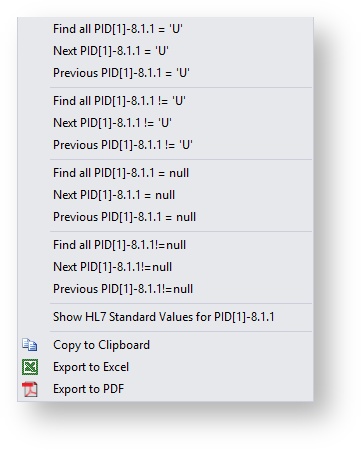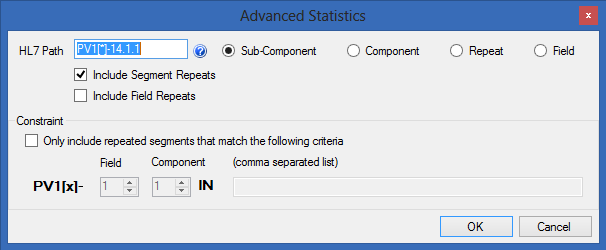| Table of Contents |
|---|
Sub-Component, Component, Repeat, and Field
...
- Unique - Shows the number of unique values found for the selected field in the active message collection. In the above example, there are only 3 unique values “M”, “F”, and “U”.
- No "SEG" - Where SEG represents the segment name of the selected field. This number describes how many messages in the active message collection were missing the segment of the requested field. This is, of course, slightly different then what is tracked in the “Null” field since having a segment and the value being NULL is different than not having the segment at all.
- Field Value Grid - These are the unique values for all messages in the active Message Tab, for the specified field. As can be seen from the figure, each value has a count (labeled as Num), and a length (labeled as Len). The default order of the grid is from most common to least common value, however; this can be changed by clicking on one of the columns of the grid. In the example above, there are 5149 messages for female patients, 4863 messages for male patients, and 16 messages where the technologist couldn't determine the patients sex. All fields have a length of 1 as you would expect for this field.
- All Button - Clicking the “All” button will cause HL7Spy to create a new Message Tab containing all messages where the selected field equals the row selected in the Field Value Grid (6). In the example above, clicking the “All” button would cause a new Message Tab to be created with all the messages where PID-8 has the value of “U”.
- Field Value Navigation - Clicking the left and right arrows buttons cause the message Editor to move to the previous and next message that have a field matching the value selected in the Field Value Grid (6), respectively.
- Right Click Menu - Right-clicking on a row in the Field Value Grid (6) displays a menu with search criteria available for the selected value.
Advanced Statistics
The "Advanced Statistics" dialog can be activated by clicking on the button in the Toolbar, or selecting the "Tools/Calculate Advanced Statistics" from the main menu. As a result, the following dialog will be displayed.
- HL7 Path - Specify the path and piece of the message (Sub-Component, Component, Repeat, or Field). Also, you have the option to include segment and field repeats.
- Constraint - Opt to "Only include repeated segments that match the following criteria" to further filter statistics.

